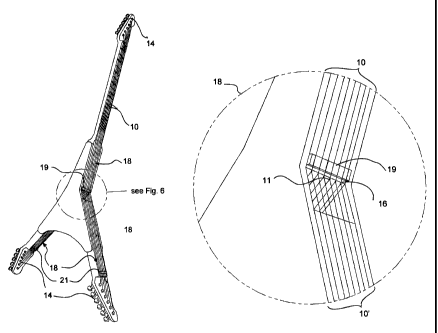Une partie des informations de ce site Web a été fournie par des sources externes. Le gouvernement du Canada n'assume aucune responsabilité concernant la précision, l'actualité ou la fiabilité des informations fournies par les sources externes. Les utilisateurs qui désirent employer cette information devraient consulter directement la source des informations. Le contenu fourni par les sources externes n'est pas assujetti aux exigences sur les langues officielles, la protection des renseignements personnels et l'accessibilité.
L'apparition de différences dans le texte et l'image des Revendications et de l'Abrégé dépend du moment auquel le document est publié. Les textes des Revendications et de l'Abrégé sont affichés :
| (12) Brevet: | (11) CA 2466645 |
|---|---|
| (54) Titre français: | RESEAUX DE CORDES MUSICALES |
| (54) Titre anglais: | MUSICAL STRING NETWORKS |
| Statut: | Réputé périmé |
| (51) Classification internationale des brevets (CIB): |
|
|---|---|
| (72) Inventeurs : |
|
| (73) Titulaires : |
|
| (71) Demandeurs : |
|
| (74) Agent: | |
| (74) Co-agent: | |
| (45) Délivré: | 2007-12-18 |
| (22) Date de dépôt: | 2004-05-12 |
| (41) Mise à la disponibilité du public: | 2004-11-12 |
| Requête d'examen: | 2004-05-12 |
| Licence disponible: | S.O. |
| (25) Langue des documents déposés: | Anglais |
| Traité de coopération en matière de brevets (PCT): | Non |
|---|
| (30) Données de priorité de la demande: | ||||||
|---|---|---|---|---|---|---|
|
Le principal objectif de la présente invention est de décrire et de mettre en pratique un phénomène par lequel une corde - c'est-à-dire une ligne droite simple d'une certaine tension, d'un certain diamètre et d'une certaine longueur qui produit une vibration - peut, lorsqu'elle est associée à un réseau d'une pluralité de cordes interreliées en un ou plusieurs points de jonction et qui en rayonnent, créer une nouvelle entité appelée « réseau de cordes » qui possède de nouvelles propriétés vibratoires. Lorsque la vibration se déplace, sous la forme d'une onde, sur le premier segment du réseau, elle se divise au premier point de jonction rencontré entre la première corde et au moins une autre corde, mais de préférence avec deux cordes ou plus. Le transfert de l'énergie de l'onde initiale aux autres cordes du réseau les fait vibrer à leur tour. Lorsque l'onde des autres cordes revient au point de jonction, un autre transfert d'énergie a lieu, si bien qu'une partie des vibrations, modifiée par les propriétés de chacune des cordes, créé un modèle de vibration qui peut être ajouté ou soustrait, ce qui donne naissance à des modèles ondulatoires complexes.
The basic premise of this invention is to describe and reduce to practice a phenomena by which a string -- which is generally known as a singular straight line having a certain tension, diameter and length that produces a vibration -- can, when put in a network consisting of a plurality of strings connected together at one or more junction points and radiating therefrom, create a new entity known as a « network of strings » which has new vibrating properties. As the vibration, in the form of a wave, travels through a first segment of the network, it splits at the first junction point met where it will travel onto at least one other string but preferably two or more strings. Transferring the original wave's energy over to the other strings in the network makes them vibrate as well and when the waves in the other strings come back to the junction, another transfer of energy occurs and part of the vibrations, which was altered by the properties of each given string, creates a pattern of vibrations which can be added or subtracted which results in complex wave patterns.
Note : Les revendications sont présentées dans la langue officielle dans laquelle elles ont été soumises.
Note : Les descriptions sont présentées dans la langue officielle dans laquelle elles ont été soumises.

Pour une meilleure compréhension de l'état de la demande ou brevet qui figure sur cette page, la rubrique Mise en garde , et les descriptions de Brevet , États administratifs , Taxes périodiques et Historique des paiements devraient être consultées.
| Titre | Date |
|---|---|
| Date de délivrance prévu | 2007-12-18 |
| (22) Dépôt | 2004-05-12 |
| Requête d'examen | 2004-05-12 |
| (41) Mise à la disponibilité du public | 2004-11-12 |
| (45) Délivré | 2007-12-18 |
| Réputé périmé | 2020-08-31 |
Il n'y a pas d'historique d'abandonnement
Les titulaires actuels et antérieures au dossier sont affichés en ordre alphabétique.
| Titulaires actuels au dossier |
|---|
| TRIFIDUS INC. |
| Titulaires antérieures au dossier |
|---|
| GAUDET, SAMUEL |
| GAUTHIER, CLAUDE |